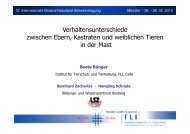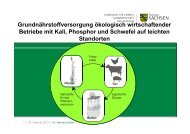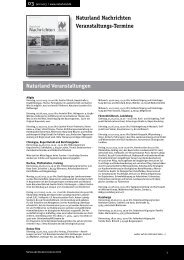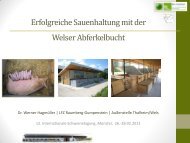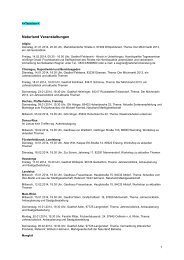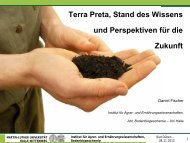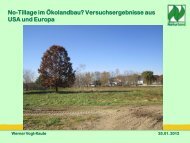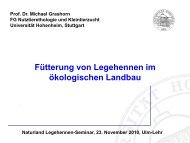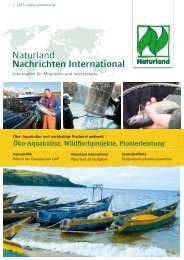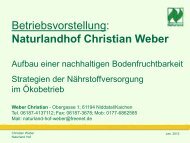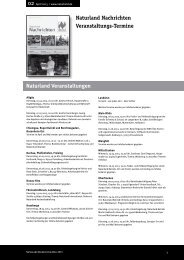Organic Farming in the Tropics and Subtropics: Sesame - Naturland
Organic Farming in the Tropics and Subtropics: Sesame - Naturland
Organic Farming in the Tropics and Subtropics: Sesame - Naturland
You also want an ePaper? Increase the reach of your titles
YUMPU automatically turns print PDFs into web optimized ePapers that Google loves.
II Special section: <strong>Organic</strong> Cultivation of <strong>Sesame</strong><br />
development can lead to erosion. Heavy, water-logged soils, as well as soils with<br />
high salt contents are not suitable; salt contents which would hardly affect cotton or<br />
safflower can already kill off sesame plants 6 . Shallow soils (less than 35 cm) with<br />
impermeable subsoils are also unsuitable.<br />
2.1.3. O<strong>the</strong>r factors<br />
<strong>Sesame</strong> needs long periods of sunsh<strong>in</strong>e, <strong>and</strong> is generally a short-day plant –<br />
whereby varieties exist which are unaffected by <strong>the</strong> length of <strong>the</strong> day. <strong>Sesame</strong> is<br />
sensitive to strong w<strong>in</strong>ds when <strong>the</strong> ma<strong>in</strong> stem is fully grown. Tall varieties should not<br />
be planted <strong>in</strong> regions which have strong w<strong>in</strong>ds dur<strong>in</strong>g <strong>the</strong> harvest<strong>in</strong>g season (<strong>and</strong>, if<br />
necessary, hedges to protect aga<strong>in</strong>st <strong>the</strong> w<strong>in</strong>d should be planted).<br />
2.2. Seeds<br />
2.2.1. Second generation <strong>and</strong> seed preparation<br />
In order to avoid cross-fertilisation of second generation crops us<strong>in</strong>g s<strong>in</strong>gle-variety<br />
seeds, care should be taken to ensure that no o<strong>the</strong>r field is be<strong>in</strong>g cultivated with<br />
o<strong>the</strong>r varieties with<strong>in</strong> a 400 m radius. Dur<strong>in</strong>g harvest<strong>in</strong>g, <strong>the</strong> plant<strong>in</strong>g seeds should<br />
not be allowed to come <strong>in</strong>to contact with <strong>the</strong> ground to avoid an <strong>in</strong>festation of soil<br />
borne diseases. The seed shells must rema<strong>in</strong> <strong>in</strong>tact to protect <strong>the</strong> seeds from<br />
<strong>in</strong>fection, <strong>and</strong> to ma<strong>in</strong>ta<strong>in</strong> <strong>the</strong>ir ability to germ<strong>in</strong>ate.<br />
2.3. Sow<strong>in</strong>g methods<br />
2.3.1. Seedbed preparation<br />
Because <strong>the</strong> seeds are so small (TCW 2.5-3.2g), <strong>and</strong> <strong>the</strong> rate of growth dur<strong>in</strong>g <strong>the</strong><br />
early phases is so slow, sesame seeds require a seed bed with firm, f<strong>in</strong>e crumbs<br />
<strong>and</strong> sufficient moisture, <strong>in</strong> order to ensure <strong>the</strong>ir rapid, uniform germ<strong>in</strong>ation <strong>and</strong><br />
subsequent growth. The seed bed should be made level <strong>and</strong> free of weeds by<br />
appropriate soil preparation, <strong>the</strong> previous crop planted <strong>and</strong> <strong>the</strong> whole system of crop<br />
rotation. This is not <strong>in</strong>tended as a fixed rule, for when mach<strong>in</strong>es are not to be used,<br />
<strong>the</strong> follow<strong>in</strong>g cultivation methods come <strong>in</strong>to play (<strong>the</strong>y are also of <strong>in</strong>terest regard<strong>in</strong>g<br />
<strong>the</strong>ir protection aga<strong>in</strong>st erosion):<br />
a) Direct sow<strong>in</strong>g <strong>in</strong> holes, with stick for support<br />
b) Sow<strong>in</strong>g after narrow strips have been prepared<br />
c) Sow<strong>in</strong>g while plough<strong>in</strong>g with an ox: a row is sown <strong>in</strong> <strong>the</strong> opened furrow from a<br />
bottle of seeds with a perforated lid, <strong>and</strong> <strong>the</strong>n covered over aga<strong>in</strong> with a branch.<br />
6 WEISS, E.A. (1983): Oilseed Crops. Longman, London.<br />
Naturl<strong>and</strong> e.V. – 1 st edition 2000 Page 4



